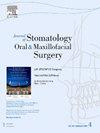Comparison of two subperiosteal implant designs in total maxillectomy: A 3-D finite element analysis
IF 2
3区 医学
Q2 DENTISTRY, ORAL SURGERY & MEDICINE
Journal of Stomatology Oral and Maxillofacial Surgery
Pub Date : 2025-04-15
DOI:10.1016/j.jormas.2025.102377
引用次数: 0
Abstract
Objective
This study aims to compare two different subperiosteal implant designs using three-dimensional finite element analysis (FEA) and to investigate the load distribution on the prosthetic components and the surrounding bone.
Material and Method
This study was conducted using a 3D representation of a Class II fully resected maxillary bone, generated. Two treatment scenarios were developed: SC-1 featured a conventional subperiosteal design, and SC-2 applied a diagonal bar design in the zygomatic region. A total force of 450 Newtons in a vertical direction and 93 Newtons in an oblique force were applied to mimic mastication forces. The maximum and minimum principal stress values on bone and von Mises stress (VMs) values on implant components' were measured.
Results
The results showed that under vertical forces, the SC-2 design exhibited higher maximum stress (Pmax) values in the zygomaticomaxillary area. Under oblique forces, stress values were higher in SC-2 in both areas compared to SC-1. VMs values on the screws were lower in SC-1 under vertical forces, while under oblique forces, they were lower in SC-2.
Conclusion
The findings suggest that the SC-2 design did not provide significant advantages over the conventional subperiosteal implant design. Future studies should focus on enhancing the conventional design by incorporating support from different anatomical areas.
两种骨膜下种植体设计在上颌全切除术中的比较:三维有限元分析。
目的:利用三维有限元分析(FEA)比较两种不同的骨膜下种植体设计,并研究假体构件和周围骨的载荷分布。材料和方法:本研究使用生成的II类完全切除的上颌骨的3D表示进行。提出了两种治疗方案:SC-1采用传统的骨膜下设计,SC-2在颧骨区域采用对角棒设计。在垂直方向上施加450牛顿的总力,在倾斜方向上施加93牛顿的总力来模拟咀嚼力。测量骨的最大、最小主应力值和种植体构件的von Mises应力(vm)值。结果:在垂直力作用下,SC-2设计的颧颌区最大应力(Pmax)值较高。在斜向力作用下,SC-2在两个区域的应力值均高于SC-1。在垂直力作用下,SC-1螺钉上的vm值较低,在斜向力作用下,SC-2螺钉上的vm值较低。结论:研究结果表明SC-2设计与传统的骨膜下种植体设计相比并没有明显的优势。未来的研究应侧重于通过结合不同解剖区域的支持来改进传统的设计。
本文章由计算机程序翻译,如有差异,请以英文原文为准。
求助全文
约1分钟内获得全文
求助全文
来源期刊

Journal of Stomatology Oral and Maxillofacial Surgery
Surgery, Dentistry, Oral Surgery and Medicine, Otorhinolaryngology and Facial Plastic Surgery
CiteScore
2.30
自引率
9.10%
发文量
0
审稿时长
23 days
 求助内容:
求助内容: 应助结果提醒方式:
应助结果提醒方式:


